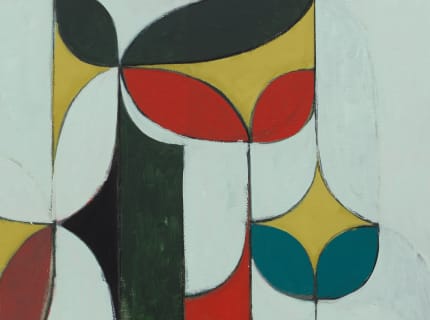Velocity and visual amplitude typify this artist’s canvases, as if he were fixing as many elements of a rapidly mutating dream as he could remember. Not that they’re formally chaotic (or invariably packed with incident); Aram is usually partial to symmetry and internal pictorial logic. Crypto-Abstract Expressionist veils and drips combine with things that are unmistakably things; the style of his work as well as its manifest content effect a hybridization we could liken to a familiar but not-quite-nameable, liquefying plant, maybe one that swallows live prey.
Aram was born in Iran in 1978 and has lived in the United States since age eight. His work riffs on imagery found in Persian miniatures and carpet patterns, Shiite posters and Arabic writing, but this material figures in contexts where original cosmological systems or hortatory meanings dissolve, or blend with Western analogues. There isn’t a pointed collision of cultures in Aram’s pictures, but rather the fluid synthesis artists conjure from what they encounter in waking and dreaming life, which can be events of trauma or epiphany or, just as easily, the casually registered minutiae of a walk down the street.
In a mass-mediated world, it’s impossible to slice a scalpel line between cultures, between “East” and “West” or similar binary constructs. The world’s contents have mingled in a vast collective potlatch available by Internet, cell phone, television, satellite and an ever-expanding inventory of connective gadgetry that looks at us while we look at it. While this universe of data is “virtual,” existing in spaces beyond our direct physical experience, it has merged with reality in a frantic delirium. One can at best stage encounters of differing sign systems and signifiers, pluck things from local contexts and set them in larger, homogenizing schemes, shift them from the subjective to the seemingly ontological. We strip the signs of meanings and intentions, and reconstitute them as bytes of the polymorphic imaginary.
...
Read full article at artnews.com

